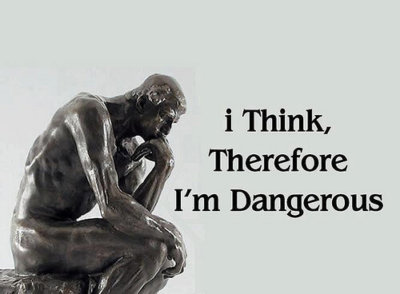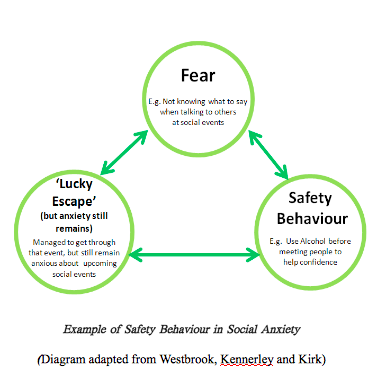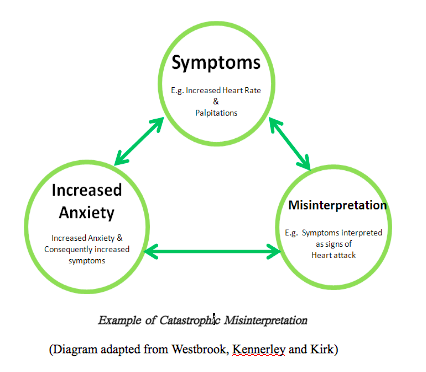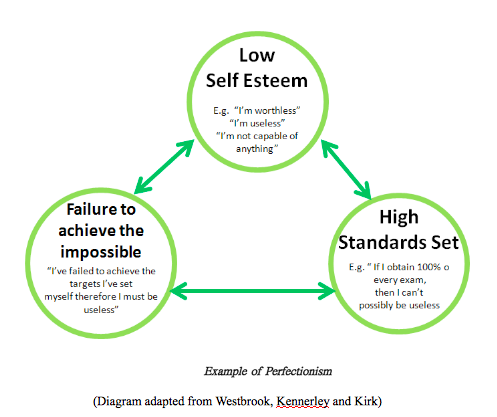How to Stop the Vicious Cycle – CBT and Dysfunctional Behaviour

By: John Eisenschenk
One of the key focuses in Cognitive Behavioural Therapy (CBT) is trying to recognise and identify the types of thoughts, feelings and behaviours you are having that are stopping you from feeling good about yourself and your life.
Cognitive Behavioural Therapy and Dysfunctional Behaviour Analysis
When you have a negative thought or feeling, or act out a negative behaviour, it often creates a pattern of dysfunctional behaviour which keeps your pessimistic mood going in a kind of vicious cycle or ‘loop’. These cycles are called ‘maintaining processes’ by therapists.
Trying to identify these cycles of dysfunctional behaviour is a key part of your first couple of CBT therapy sessions, where you and your cognitive therapist will do a behavioural analysis and together recognise your patterns so you can then intercept and change them.
Let’s look at the most common kinds of ‘maintaining processes’ that CBT counselling identifies.
The 7 Most Common Dysfunctional Behaviour Loops
1. Safety Behaviours
 Safety behaviours occur when you want to protect yourself from something you fear. They are often related to anxiety. If you suffer social anxiety, examples of this type of behaviour include agreeing with everything the other person says, speaking very quietly, sticking to ‘safe’ conversations, tensing up to control shaking and using alcohol and drugs to increase confidence.
Safety behaviours occur when you want to protect yourself from something you fear. They are often related to anxiety. If you suffer social anxiety, examples of this type of behaviour include agreeing with everything the other person says, speaking very quietly, sticking to ‘safe’ conversations, tensing up to control shaking and using alcohol and drugs to increase confidence.
While it is understandable to try and cope with unpleasant feelings of anxiety, these behaviours can actually end up prolonging feelings of anxiety. This is because the actual problem remains unresolved and is allowed to continue. For instance, although you managed to feel less anxious the last time you had to attend a party because you got tipsy on alcohol, you are still going to have anxiety the next time you have have a social event to go to.
2. Escape/Avoidance
It’s very common when you are feeling anxious to want to run away from the situation that is making you feel tense. This is why if you suffer social anxiety you might tend to avoid social situations entirely, choosing to be on your own and withdraw. Or you may go out but avoid eye contact, stand on the edge of a group, and hope no one will talk to you. Like other safety behaviours, avoidance and escape can actually make your anxiety worse in the long run, because they undermine your confidence and prevent you from discovering if your fears are founded on reality or are just extreme and unhelpful.
3. Reduction in Activity
This is the most common maintaining process when it comes to depression. Often when you are depressed you suffer from low mood, negative thoughts and physical symptoms such as a reduction in energy. This all leads to giving up doing activities that usually give you feelings of pleasure and achievement. You might find yourself instead just doing the bare minimum of activity required to get by.
Unfortunately, this can just make you feel even more demoralised, as you are disconnecting yourself from what usually gives you joy. Then there is the way it reduces your access to support and encouragement from the friends you might have done those activities with, and increases the amount of time you have available to think negative thoughts. It can become a vicious cycle of more and more reductions in activity until even necessary actions like washing, cooking, or leaving the house become unthinkable.
4. Catastrophic Misinterpretation
 If you suffer from anxiety about your health and/or OCD you might be prone to this dysfunctional behaviour process, where you misinterpret bodily sensations as evidence of more serious physical and psychological illness. Anxiety symptoms such as increased heart rate, dizziness, palpitations (heart flutters), and shortness of breath are interpreted as more serious threats such as heart attacks, strokes or that you are about to “go mad”.
If you suffer from anxiety about your health and/or OCD you might be prone to this dysfunctional behaviour process, where you misinterpret bodily sensations as evidence of more serious physical and psychological illness. Anxiety symptoms such as increased heart rate, dizziness, palpitations (heart flutters), and shortness of breath are interpreted as more serious threats such as heart attacks, strokes or that you are about to “go mad”.
The result of thinking such thoughts is that often more anxiety is generated and the symptoms worsen, which appears to confirm the imminent threat to your wellbeing.
5. Scanning/Hyper-vigilance
This is another common behavioural loop if you suffer health anxiety, and also occurs with sufferers of Post Traumatic Stress Disorder. It’s occurs when you are worried you could have a serious illness and often scan or are hyper-vigilant to symptoms which you believe confirms you have the illness. This process makes you more sensitive to picking up on perfectly normal bodily symptoms and interpreting them as confirmation of illness. This then increases your anxieties and worries which leads to further scanning and checking, and the vicious cycle is created.
6. Self-Fulfilling Prophecies
If you possess negative beliefs about others’ attitudes towards you, you may very well then elicit reactions from those people which appear to confirm your original negative belief. For example, the expectation that others will be aggressive and hostile towards you may mean that you walk around with quite defensive behaviour, which actually does elicit aggression from others and confirms your belief that others are aggressive towards you.
The perfectionism loop is a common one if you suffer from low self-esteem and confidence. You set yourself almost impossible high standards in order to prove your capabilities and worth. “If I’m perfect, then I can’t be useless”. But by setting such abnormally high standards you can almost never achieve, you instead reinforce that you are “useless” and “not worthy”. Your low self-esteem is maintained and even reinforced.
Recognise Any of these Examples of Behaviours?
Remember, acknowledgement is key. If you recognise any of these types of thoughts or examples of behaviours in yourself, you have made an important first step in trying to break your cycle of dysfunctional behaviour. Try monitoring when and how often you think such thoughts or behave in such a way, and notice in what situations the cycles occur. By identifying when you are engaging in a loop, you can begin to change the process of events and more importantly gain back the control of how you think and behave.
Do you have questions about CBT? Or not sure you are in a loop of dysfunctional behaviour and want to ask a question? Use the comment box below. We love hearing from you.






l am suffering from post trauma stress can u offer any help. Driving me crazy.
Well you are the right track posting on a CBT article. CBT is evidence-based to help with PTSD, so a round of CBT therapy is advised for PTSD. We’d also suggest looking for a therapist who offers EDMR. https://www.harleytherapy.co.uk/counselling/what-is-edmr-therapy.htm
I am suffering with very bad anger issues and my anxiety and stress levels are through the roof and I’m suffering with insomnia at The moment I just don’t know what to do my. Doctor has put me back on my meds which I didn’t want to do but needs must I’m lonely and lost at the moment!!
Graham we are sorry to hear you are having such a bad go of it. Loneliness can of course make things worse, as we feel so unsupported, so we do hope that there is someone you can talk to. If you don’t have a psychotherapist and can’t afford one, don’t be afraid to use a help line. That is what they are there for. You can find a list of places to call in the UK here and if you aren’t in the UK just google ‘mental health help line’ or ‘hot line’ in your country. bit.ly/mentalhelplines We’d also suggest you look at some of other articles, such as this one here https://www.harleytherapy.co.uk/counselling/how-can-i-be-less-sensitive.htm and if you go to our free guides page you’ll find guides to anger management as well as sleep problems https://www.harleytherapy.co.uk/counselling-information.htm Finally, a great free tool for anger and insomnia is mindfulness, have you heard of it? Access our free easy to use guide here – bit.ly/mindfulnessallabout WE WISH YOU COURAGE!
I am suffering from tricotilimania will cut help
CBT might help, worth a try!
Im reaching the end of point of living. My dad died, my son has disabilities, my wife cant
deal with me and I am off work with sickness for 18 months now and face redundancy when I go back. My job has gone offshore and my skill set and education is very low. I get paid 40% IP ins and it barely pays the mortgage. I am going in loops like above and my psychiatrist has told me I’m better off staying as I am as without a phased return he sees me relapsing.
Im in despair and cant cope. CBT didn’t work and I am at my lowest ebb. The job market in my field non exists now as all areas where I work seemed to have automated or shifted out of the country and I cant deal with the worry. I need help as my thoughts are facts and this is the reality.
Jason. First of all, we are glad to hear you have support. Second of all, you say CBT didn’t work. Are you still doing it? How long have you been working on it? It doesn’t work overnight, and you have to do the homework assignments and the thought charts daily. If you are not doing the thought charts and are just telling your therapist you are, then that is pointless. So you have to give full commitment and not sabotage. Finally, you say ‘my thoughts are facts’. No, actually, they are not facts. they are projected worries and asusmptions. Yes, you have a disabled son and your dad died. We are sorry to hear that. Those are two facts. Your wife can’t deal, assumption, if she’s still there, she is dealing. Assuming you can’t find work, another assumption. And there is a huge lack of balanced thinking here. For example, there are many people who have no family at all, nowhere to live, could never ever even qualify for a mortgage, can’t afford or access any sort of mental health help at all. Your thoughts are stuck in the negative track and the reality you are seeing is not factual but through a filter. We’d advise you start a daily gratitude practice which is proven by research to help people addicted to negative thinking http://bit.ly/gratitudepractise and consider starting mindfulness https://www.harleytherapy.co.uk/mindfulness-help-guide.htm. And then continue the CBT. Of course for any therapy to work you have to want it to work. Negative thinking is actually highly addictive for many of us, it becomes our comfort zone, and helps us constantly create a life we are miserable. How comfortable are you with feeling good? And letting go of negativity? Something to think about.
Only do edmr therapy if you can identify a safe place. I did and and I almost had a nervous breakdown in the therapist’s Office
We are sorry to hear about this Mays. EMDR is extremely powerful, you would need to have a stable place to recover in between sessions, good point. Thanks.
I tried CBT for self-esteem while also dealing with PTSD and suicidal ideation. I would get stuck on identifying positive things about me because I see myself as a disgusting monster that needs to be put down. I don’t want it to work because I don’t deserve it. Is there anything I can do that will help even when I feel like I don’t want it to work?
CBT is often great for PTSD. But if you have seriously low self esteem, you might need a warmer relationship with a therapist than CBT provides. CBT does tend to be quite rigid and formal. You might, for example, do very well with a schema therapist http://bit.ly/schematherapy or with someone who offers compassion-focused therapy http://bit.ly/compassionbased. Otherwise clinical hypnotherapy can be helpful http://bit.ly/hypnotherapyUK. And EMDR is highly recommended for trauma and PTSD. It’s more of an immersive experience than CBT, so there is less control of your thoughts, so might be ideal http://bit.ly/2XSkxKp